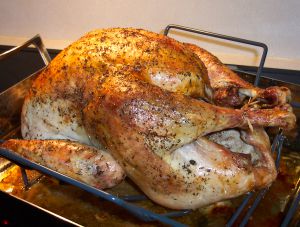Guide and Tips for Roasting Turkey
There are all sorts of methods used in the never-ending quest to make the perfect turkey with thoroughly cooked thighs and legs but a moist breast, and a beautifully browned, crispy skin. Some include covering the bird with buttered cheesecloth (tried that...very good but messy), roasting breast side down and then turning over (tried that...works well, but cumbersome), tenting the breast with foil for part of the roasting time (helps keep the breast moist, but the skin does not get as brown and crispy as I like), roasting until slightly pink, then cutting into parts that are finished by various other methods (works well with duck but have not tried with a turkey), trussing, not trussing, stuffing, not stuffing, brining, deep frying, etc...etc...etc.
Several years ago, I cut the bird into breast, leg, thigh and wing portions and roasted them in one pan. That works very well because the heat circulates evenly around each piece and, if the breast gets done early, it can be removed and kept warm until the other parts are done. Depending on where you live, you might be able to purchase the parts separately, which is a bit more expensive, or find a butcher that will cut it for you. However, if you prefer to stick with tradition and present a whole bird, follow the guidelines below and see the similar and related recipes for specific presentations.

What Size of Turkey to Purchase
The size of the turkey you purchase is somewhat subjective. I, for one, used to love to roast a big bird even when there was a small gathering. I loved the massive look and the hours of heavenly aroma coming from the oven. However, practicality (and endless leftovers) should dictate the correct size for the event. And it is much easier to roast smaller birds without drying them out so, even for large crowds, it is best to use two smaller birds, between 10 and 14 pounds each. Generally, 1-1/2 pounds per person will yield generous portions and ample leftovers. You must have some leftovers.
How to Get a Crispy Skin
Everyone likes a turkey with a crispy skin. The best way to achieve that is to remove the wrap from the turkey and refrigerate overnight so that the skin dries out. I tried it and it really does work with a whole bird or cutup parts. Even if it is not practical to do overnight, do it the morning or for as many hours as you can. Place the turkey on a sheet or other pan large enough to catch any drippings and make certain that nothing else in the refrigerator comes into contact with the uncovered, raw bird. The same method works with any poultry.
Stuffing the Turkey
Honestly, it is best to bake the stuffing in an individual baking dish because the turkey will almost always dry out by the time the stuffing is thoroughly cooked. If you add some of the broth that you prepared to make gravy, the stuffing, called dressing when baked in a casserole, will have lots of flavor. However, if you still want to stuff the bird, follow these simple rules. Never stuff a bird with hot stuffing. Make sure it is thoroughly cooled. Do not overstuff the bird. Place extra stuffing in a small casserole and bake alongside of the roasting pan. You will need to add about 30 minutes to the roasting time if the bird is stuffed, and the stuffing must reach an internal temperature of 180° before serving. (Imagine how overcooked the turkey will be at that point.) Then, when serving, remove all of the stuffing from the bird so that it does not sit in a hot environment that can quickly cause spoilage.
Roasting Times and Temperatures
There are basically two different roasting methods for poultry. Small birds benefit from a quick method that starts at a high temperature for a short time to brown the skin, followed by a lower temperature to cook the meat and keep it moist. The slow method uses a low temperature for the entire roasting period. I prefer the slow roast method for large birds such as turkey because they remain in the oven long enough for the skin to brown. Baste often with pan juices, about every 20 to 30 minutes. All poultry needs to be at an internal temperature of 170° F in the thickest part of the thigh before removing from the oven. Then it needs to rest for 20 minutes before carving so that the juices redistribute back into the meat. During that time, the internal temperature will rise to the appropriate 180°. If you are roasting the breast separately, it can be removed at 160° so it will end up at 170°.
The following is just a guide. It gives you an idea how long it will take to roast the bird, but is not exact, so allow for a little extra time if you have a serving deadline. In all cases, take the turkey out of the refrigerator 30 to 60 minutes before roasting.
| Size of Bird |
Approximate Roasting Time at 325° F (160° C) |
| 5 - 12 lbs (2.5 - 5 k) |
2 - 3 hours |
| 12 - 18 lbs (5 - 8 k) |
3 - 4 hours |
| 18 - 25 lbs (8 - 11 k) |
4 - 5 hours |

No matter where I take my guests, it seems they like my kitchen best.
Pennsylvania Dutch Saying
This site may not be reproduced in whole or in part without written permission and appropriate credit given. Written, designed and maintained by Teri Ranck Foster. All rights reserved. Copyright Statement, Privacy Policy and Disclaimers.


